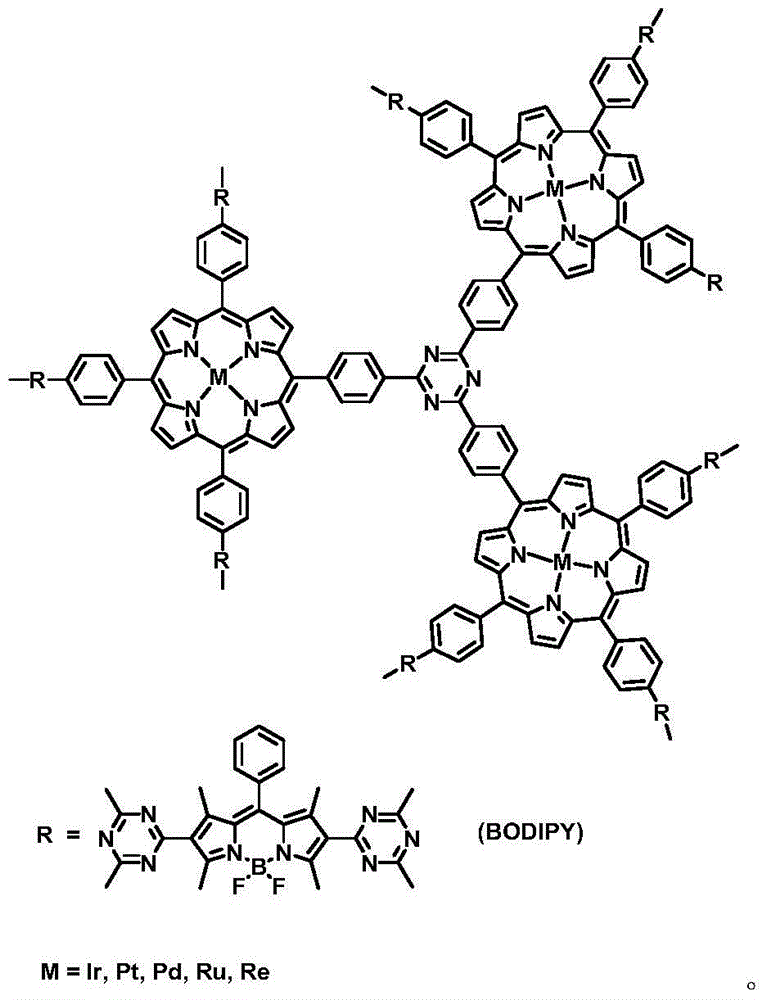Ratio-type transition metal porphyran polymer luminescent oxygen sensing material
A technology based on porphyrin polymers and transition metals, applied in luminescent materials, material excitation analysis, fluorescence/phosphorescence, etc., can solve problems such as inaccurate oxygen measurement
- Summary
- Abstract
- Description
- Claims
- Application Information
AI Technical Summary
Problems solved by technology
Method used
Image
Examples
Embodiment 1
[0024] 1: Synthesis of meso-5,10,15,20-tetra(cyano)porphyrin
[0025] Firstly, p-cyanobenzaldehyde (1.31g, 10mmol) was dissolved in 20mL of propionic acid, and freshly distilled pyrrole (0.737g, 11mmol, 0.76mL) was dissolved in 10mL of propionic acid. Then, under the protection of nitrogen, the propionic acid solution of pyrrole was slowly added dropwise to the propionic acid solution of p-cyanobenzaldehyde, heated to 80° C. for 1 h, cooled to room temperature, filtered, and the filter cake was washed with absolute ethanol. Purification by column chromatography with dichloromethane as the eluent gave a dark purple solid.
[0026] 2: Synthesis of meso-5,10,15,20-tetrakis(cyano)porphyrin platinum complex
[0027] PtCl 2 (37.0mg, 0.14mmol) was added to 35mL of benzonitrile, heated to reflux for 4h, and the PtCl 2 After all dissolved in benzonitrile, meso-5,10,15,20-tetra(cyano)porphyrin (32.8 mg, 0.046 mmol) was added, and the reflux reaction was continued for 2 h. Benzonitri...
Embodiment 2
[0031] 1: Synthesis of meso-5,10,15,20-tetra(cyano)porphyrin
[0032] Firstly, p-cyanobenzaldehyde (1.31g, 10mmol) was dissolved in 20mL of propionic acid, and freshly distilled pyrrole (0.737g, 11mmol, 0.76mL) was dissolved in 10mL of propionic acid. Then, under the protection of nitrogen, the propionic acid solution of pyrrole was slowly added dropwise to the propionic acid solution of p-cyanobenzaldehyde, heated to 80° C. for 1 h, cooled to room temperature, filtered, and the filter cake was washed with absolute ethanol. Purification by column chromatography with dichloromethane as the eluent gave a dark purple solid.
[0033] 2: Synthesis of meso-5,10,15,20-tetra(cyano)porphyrin iridium complexes
[0034] IrCl 3 (41.7mg, 0.14mmol) was added to 35mL of benzonitrile, heated to reflux for 4h, and the IrCl 3 After all dissolved in benzonitrile, meso-5,10,15,20-tetra(cyano)porphyrin (32.8 mg, 0.046 mmol) was added, and the reflux reaction was continued for 2 h. Benzonitrile...
Embodiment 3
[0038] 1: Synthesis of meso-5,10,15,20-tetra(cyano)porphyrin
[0039] Firstly, p-cyanobenzaldehyde (1.31g, 10mmol) was dissolved in 20mL of propionic acid, and freshly distilled pyrrole (0.737g, 11mmol, 0.76mL) was dissolved in 10mL of propionic acid. Then, under the protection of nitrogen, the propionic acid solution of pyrrole was slowly added dropwise to the propionic acid solution of p-cyanobenzaldehyde, heated to 80° C. for 1 h, cooled to room temperature, filtered, and the filter cake was washed with absolute ethanol. Purification by column chromatography with dichloromethane as the eluent gave a dark purple solid.
[0040] 2: Synthesis of meso-5,10,15,20-tetra(cyano)porphyrin palladium complexes
[0041] PdCl 2 (24.8mg, 0.14mmol) was added to 35mL of benzonitrile, heated to reflux for 4h, and the PdCl2 After all dissolved in benzonitrile, meso-5,10,15,20-tetra(cyano)porphyrin (32.8 mg, 0.046 mmol) was added, and the reflux reaction was continued for 2 h. Benzonitrile...
PUM
 Login to View More
Login to View More Abstract
Description
Claims
Application Information
 Login to View More
Login to View More - R&D
- Intellectual Property
- Life Sciences
- Materials
- Tech Scout
- Unparalleled Data Quality
- Higher Quality Content
- 60% Fewer Hallucinations
Browse by: Latest US Patents, China's latest patents, Technical Efficacy Thesaurus, Application Domain, Technology Topic, Popular Technical Reports.
© 2025 PatSnap. All rights reserved.Legal|Privacy policy|Modern Slavery Act Transparency Statement|Sitemap|About US| Contact US: help@patsnap.com


